Cereal and oilseed rape harvest: final estimates - 2019
Statistics on area, production and yield of cereals in Scotland in 2019.
This document is part of a collection
Cereal and Oilseed Rape Harvest 2019: Final Estimates
Introduction
A National Statistics Publication for Scotland
Main Findings
2019 was the highest year for cereal production since 2015. Production increased by 22 per cent in 2019. This was
due to an increase of 19 per cent in yield, as the area sown only increased by 2 per cent.
The increase in yield is largely due to improved weather conditions in 2019, with 2018 being a poor year for both yield and production.
All crops saw an increase in yield in 2019. The largest was for wheat at 28 per cent.
Commonly used terms
Hectares: the official measurement of agricultural land. One hectare is 10,000 square meters or roughly the same as a full- size rugby pitch.
Production: the total amount of crops that are produced measured in metric tonnes.
Yield: the amount of produce, weighed in tonnes, that is harvested per hectare of land.
Cereal production up across all regions of Scotland
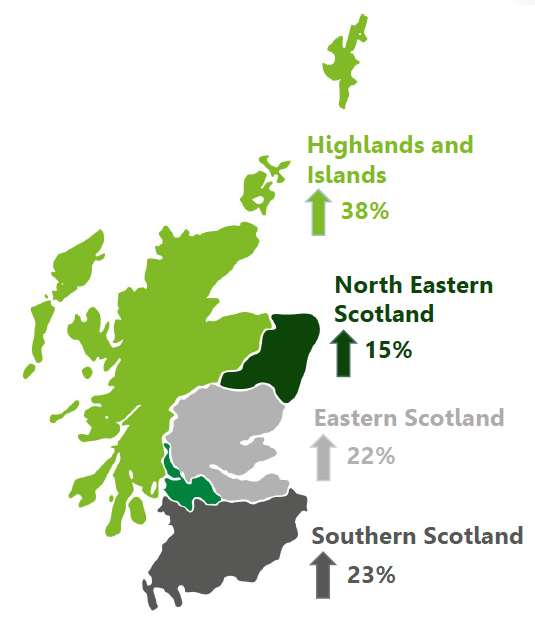
Cereal production increased across the whole country. Highlands and Islands saw a 38 per cent increase in production and a 33 per cent increase in yield.
Having had significantly lower yields in 2018, Highlands and Islands had similar yields to North Eastern Scotland in 2019.
West Central Scotland saw increased production due to an increase in area and yield. However, only around 0.5% of cereals were grown in West Central Scotland and these changes may not be significant.
All cereals saw an increase in production
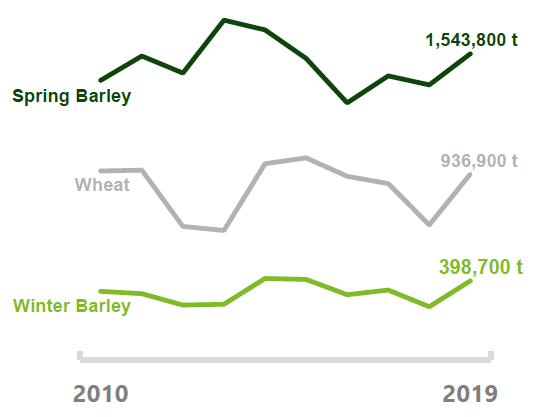
UP 49% - Winter Barley
In 2019 production increased for all cereals. The increase is due to the improved growing conditions over the year, with 2018 having been a particularly poor year.
Winter barley saw the largest increase in production. This was due to more favourable weather during the winter months meaning a greater area was sown.
The winter and early part of the year saw better weather than 2018. However, there was poorer weather towards the end of the growing season and into the harvest that may have led to poorer quality grain.
Highest cereal yields for 20 years
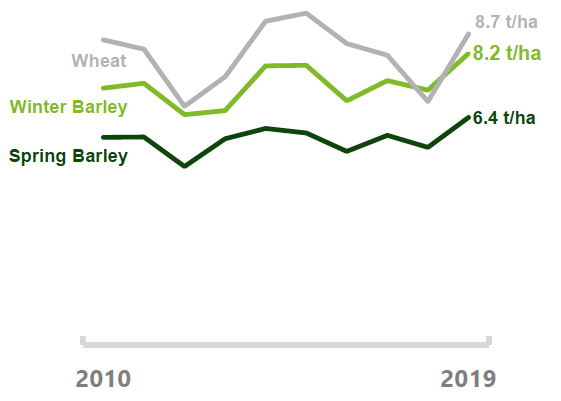
UP 28% - Wheat
2019 was a record year for yield. At 7.1 t/ha, this was the highest yield for the last 20 years.
All crops saw an increase in yield in 2019. The largest increase was for wheat at 28 per cent. This was largely due to a particularly poor year in 2018.
Both winter and spring barley saw the highest yields for the last 20 years.
Wheat and winter barley saw large increases in both area sown and yield, resulting in large increases in production.
Record yields for spring barley
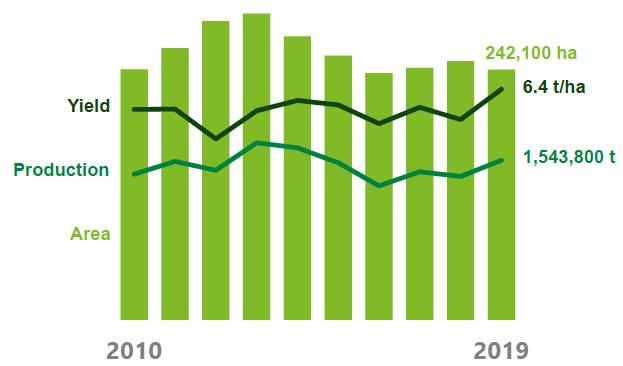
Spring barley accounts for 48% - Total crop production
Spring barley saw its highest yield in the last 20 years. Despite a small reduction in area sown, production increased by 11 per cent.
Spring barley accounts for almost half of the crop production in Scotland. Combined with winter barley this makes up 61 per cent of total crop production.
Barley is the main cereal crop grown in Scotland. Spring barley is sown around March, whereas winter barley is sown in the autumn.
In 2019, around 80 per cent of barley production was made up of spring barley.
Winter barley production increases by almost 50 per cent
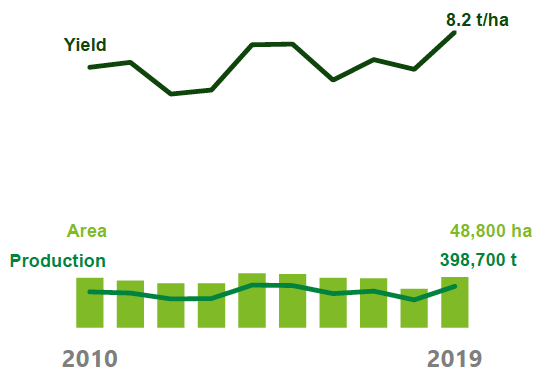
Winter barley accounts for 12% - Total crop production
The area of winter barley sown increased by 30 per cent in 2019. This was due to more favourable weather conditions over the winter months compared to the previous year.
The improved weather conditions also led to a 14 per cent increase in yield and a 49 per cent rise in production.
Industry experts have stated that while yields may be higher this year, the quality of the winter barley crop has been disappointing and may only just meet the specification required for malting.
Barley is as a key ingredient for the Scottish whisky industry, with 54 per cent of the 2018 crop sold to merchants for malting.
However, around 40 per cent of barley was used as animal feed.
Large increase in wheat production and yield
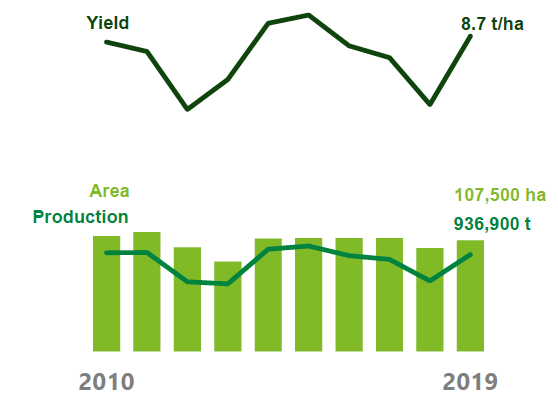
Wheat accounts for 29% - Total crop production
Wheat saw the largest increase in yield at 28 per cent. Combined with an 8 per cent increase in area sown this resulted in a 38 per cent increase in production.
Expert advice indicated the wheat harvest was very good at the start of 2019, however the later half of the year has seen a reduction in quality.
Scottish wheat is mainly soft wheats that are used for distilling. In 2018, around 40 per cent of wheat was sold to merchants for malting.
Scotland imports hard wheats for milling (generally used for bread-making) because our climate does not suit hard wheat varieties.
Oats see increase in yield and production
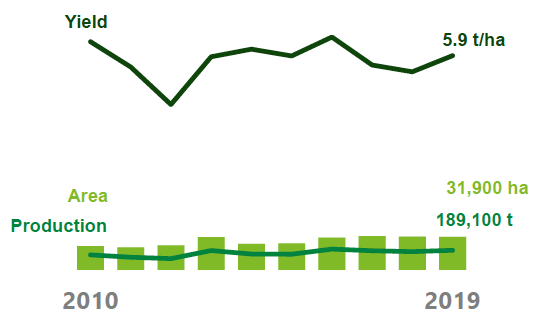
Oats account for 6% - Total crop production
Yield and production for oats increased in 2019, despite a small decrease in the area sown.
Oat production and yield both increased by 8 per cent this year. However, industry experts have indicated the quality of the crop might be lower this year due to bushel weight being down and issues with sprouting.
The majority of oats grown in Scotland are sown in the spring and are used for milling. In 2018, almost 70 per cent of oats were used for milling.
Oats are also used in specialist animal feed and in further processing for oatcakes and porridge oats.
Initial estimates are generally good predictors of final results
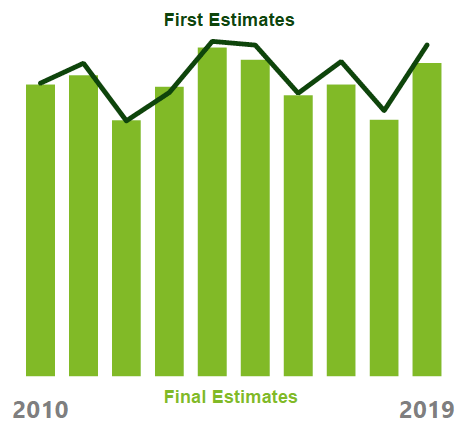
Initial estimates of the cereal harvest are published in October. They are generally quite accurate, although in recent years production and yield have been slightly higher than the final estimates.
This can be due to a number of factors; changes in weather during the harvest season and quality of cereals harvested can result in differences between the first and final estimates.
In 2020 we will investigate ways to improve the accuracy of our first estimates, incorporating forecasting techniques to complement the information provided by industry experts.
How first estimates are calculated
Our annual harvest first estimates are based on advice from industry experts on expected yields. We combine this with census results for the areas grown to estimate the total amount of production.
First estimates are fairly accurate
The data collected on areas grown is very good. However, first and final yield estimates can vary as more information is collected once the harvest has been completed.
Contact
Email: stephen.smith@gov.scot
There is a problem
Thanks for your feedback